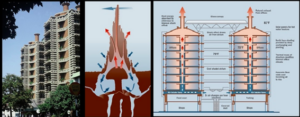What do you think of when you hear “termites”? Before this research, I would slightly wince as I often do with all animals synonymous with pests. Once exploring the natural habits of Earth’s creatures, I quickly realized that these insects are some of the best builders out there. In fact, they are referred to as the animal kingdom’s “champion master builders” [1]. Mound-building termites, most often found in tropical regions, have been building sustainable skyscrapers long before humans. Sharing the same foundational motivation for construction- providing shelter, protection, and the regulation of temperature and air circulation, we are a lot more like termites than we think. Where we differ is the outcomes of these motivations and the external energy sources humans use to meet their construction desires.
synonymous with pests. Once exploring the natural habits of Earth’s creatures, I quickly realized that these insects are some of the best builders out there. In fact, they are referred to as the animal kingdom’s “champion master builders” [1]. Mound-building termites, most often found in tropical regions, have been building sustainable skyscrapers long before humans. Sharing the same foundational motivation for construction- providing shelter, protection, and the regulation of temperature and air circulation, we are a lot more like termites than we think. Where we differ is the outcomes of these motivations and the external energy sources humans use to meet their construction desires.
Mound-building termites construct tall homes, some as tall as 40 feet, to protect the colony. They do this using a mixture of soil (containing clay and sand), their saliva, and their dung. [3] Throughout the walls of the mound are meticulously placed holes to allow for a homeostatic environment. In many ways, these termite mounds are solar powdered! They design their mounds based on the sun’s movement throughout the day. [2] The varying heat drives the internal airflow, maintaining a stable temperature within. For example, termites in Zimbabwe primarily eat fungus farmed in their mound which remains at a temperature of 87 degrees F while temperatures outside range from 35-104 degrees F during the day. [5] This is quite impressive temperature regulation!
This regulation is crucial as temperature is one of the most significant environmental characteristics of survival for all organisms. So how can we utilize termites’ masterful building techniques? … Well, architect Mike Pearce did just that! In 1991, Pearce was hired by an investment group in Harare, Zimbabwe to design the largest retail and office building in the country. He was challenged to do this without an expensive AC system. So, he looked to termite mounds for inspiration and designed a building that cools itself! His design resulted in the impressively sustainable Eastgate Centre with a “90% natural climate control system” [4]. Like the clay termite mounds, the building is made up of concrete slabs and brick which have a high thermal mass. At night, low power fans push cool air throughout the building, which is absorbed by the concrete slabs, insulating the building. During the hot day, warm air is vented up and out through large chimneys. This building maintains a fair 82 degrees F during the day and 57 degrees F during the night all while using 35% less energy than typical buildings in Zimbabwe. [4]

Mound-building termites have perfected their craft through different techniques that capitalize on the “use of local materials, the enhancement of air circulation, and energy efficiency without an external supply of power” [1]. The Eastgate Centre is a perfect example of how biomimicry can be used to not only inspire more sustainable design but increase our appreciation for the little ingenious buggers around us.
References:
- “Termite Mounds: Bioinspired Examination of the Role of Material and Environment in Multifunctional Structural Forms” (2018) journal article accessed through ASCE library: https://ascelibrary.org/doi
- “What Termites Can Teach Engineers” (2019) article by Mark Wolverton accessed through ASME: https://www.asme.org/topics-resources/content/what-termites-can-teach-engineers
- “The Incredible Termite Mound” (2011) article accessed throuh PBS: https://www.pbs.org/wnet/nature/the-animal-house-the-incredible-termite-mound.
- “See How Termites Inspired a Building That Can Cool Itself” (2018) NatGeo YouTube video: https://youtu.be/620omdSZzBs
- “Green Building in Simbabwe Modeled After Termite Mounds” (2012) by Jill Fehrenbacher: https://inhabitat.com/building-modelled-on-termites-eastgate-centre-in-zimbabwe
- “Termites’ Cathedral Mounds” (2015) by Sophia Nguyen https://www.harvardmagazine.com/2015/11/termites-cathedral-mounds
- “Biomimicry Architecture” (2018) article by Benyoucef Yassine Mohammed and Razin Andrey: pdfs.semanticscholar.org/9124/2c92b37e4468de69cdfedfe8e4cf83354db9.pdf?_ga=2.250225222.170370056.1652477303-314123988.1652477303 [Eastgate Centre schematic]
Leave a Reply